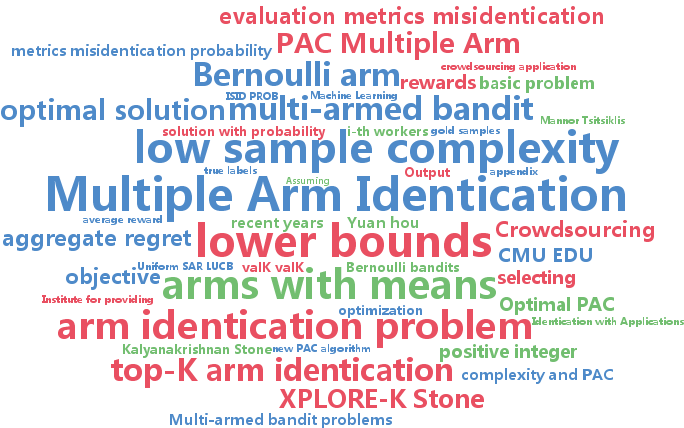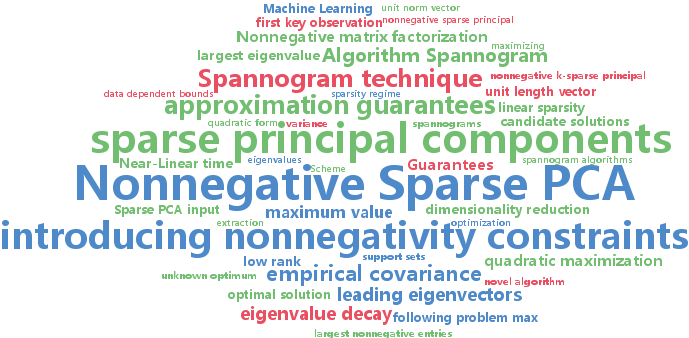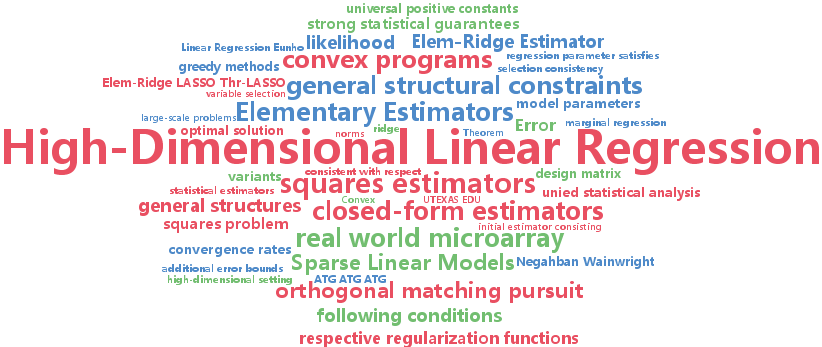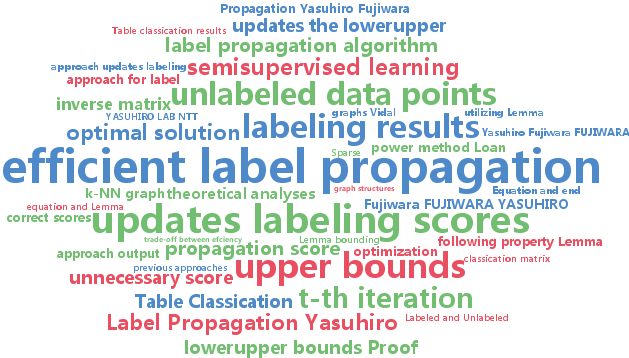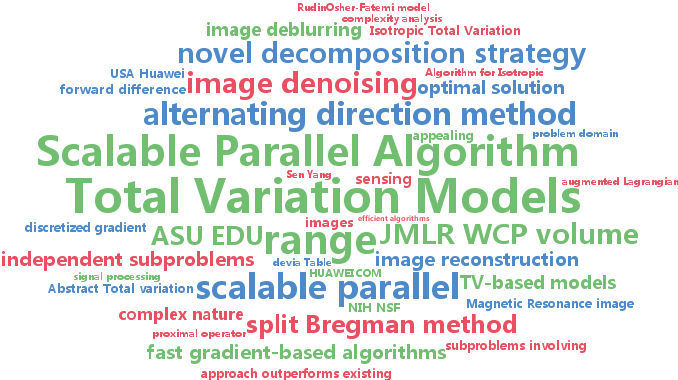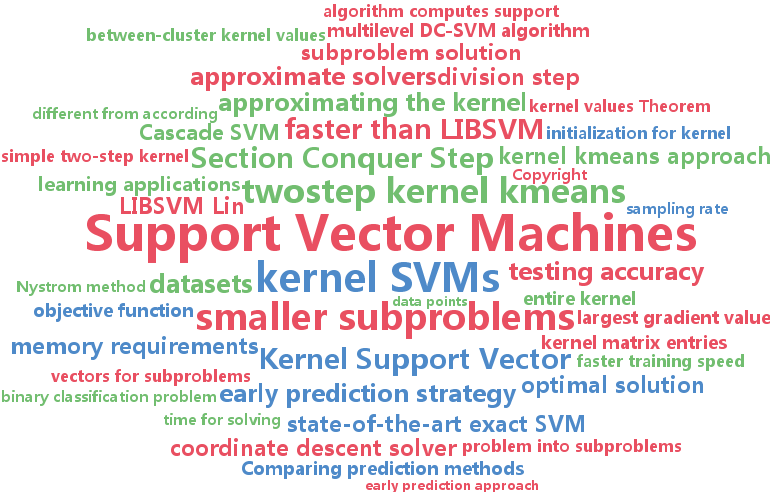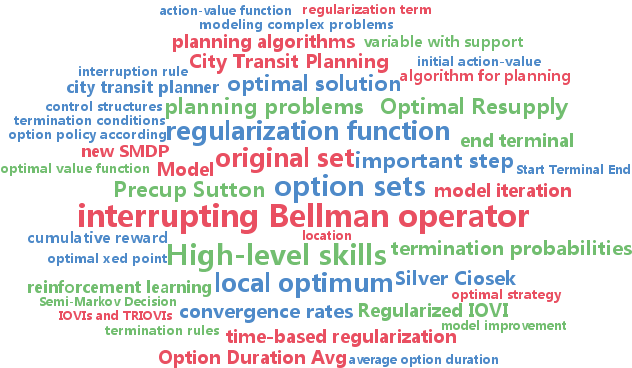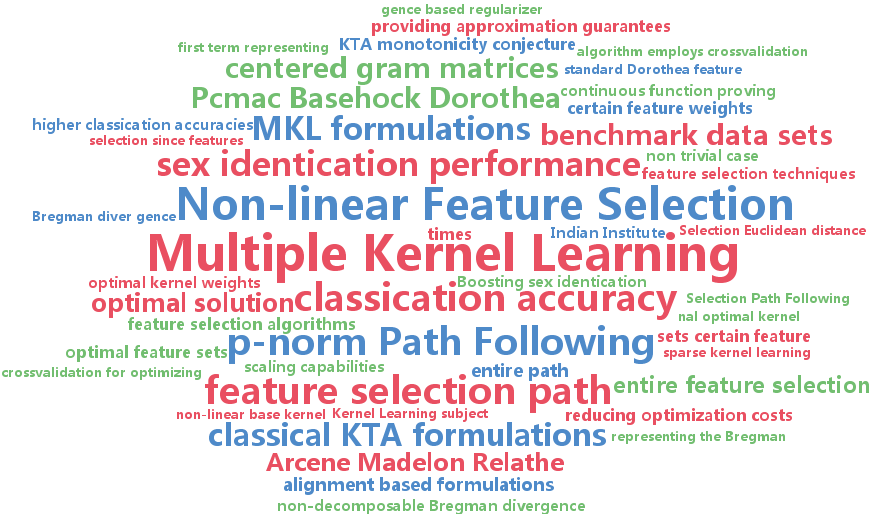optimal solution
-
Yuan Zhou and Xi Chen and Jian Li
Optimal PAC Multiple Arm Identification with Applications to Crowdsourcing (pdf)
We study the problem of selecting $K$ arms with the highest expected rewards in a stochastic $N$-armed bandit game. Instead of using existing evaluation metrics (e.g., misidentification probability or the metric in EXPLORE-K), we propose to use the aggregate regret, which is defined as the gap between the average reward of the optimal solution and that of our solution. Besides being a natural metric by itself, we argue that in many applications, such as our motivating example from crowdsourcing, the aggregate regret bound is more suitable. We propose a new PAC algorithm, which, with probability at least $1-\delta$, identifies a set of $K$ arms with regret at most $\epsilon$. We provide the sample complexity bound of our algorithm. To complement, we establish the lower bound and show that the sample complexity of our algorithm matches the lower bound. Finally, we report experimental results on both synthetic and real data sets, which demonstrates the superior performance of the proposed algorithm.
-
Qihang Lin and Lin Xiao
An Adaptive Accelerated Proximal Gradient Method and its Homotopy Continuation for Sparse Optimization (pdf)
We first propose an adaptive accelerated proximal gradient(APG) method for minimizing strongly convex composite functions with unknown convexity parameters. This method incorporates a restarting scheme to automatically estimate the strong convexity parameter and achieves a nearly optimal iteration complexity. Then we consider the ℓ1-regularized least-squares (ℓ1-LS) problem in the high-dimensional setting. Although such an objective function is not strongly convex, it has restricted strong convexity over sparse vectors. We exploit this property by combining the adaptive APG method with a homotopy continuation scheme, which generates a sparse solution path towards optimality. This method obtains a global linear rate of convergence and its overall iteration complexity has a weaker dependency on the restricted condition number than previous work.
-
Megasthenis Asteris and Dimitris Papailiopoulos and Alexandros Dimakis
Nonnegative Sparse PCA with Provable Guarantees (pdf)
We introduce a novel algorithm to compute nonnegative sparse principal components of positive semidefinite (PSD) matrices. Our algorithm comes with approximation guarantees contingent on the spectral profile of the input matrix A: the sharper the eigenvalue decay, the better the approximation quality. If the eigenvalues decay like any asymptotically vanishing function, we can approximate nonnegative sparse PCA within any accuracy $\epsilon$ in time polynomial in the matrix size $n$ and desired sparsity k, but not in $1/\epsilon$. Further, we obtain a data-dependent bound that is computed by executing an algorithm on a given data set. This bound is significantly tighter than a-priori bounds and can be used to show that for all tested datasets our algorithm is provably within 40%-90% from the unknown optimum. Our algorithm is combinatorial and explores a subspace defined by the leading eigenvectors of A. We test our scheme on several data sets, showing that it matches or outperforms the previous state of the art.
-
Eunho Yang and Aurelie Lozano and Pradeep Ravikumar
Elementary Estimators for High-Dimensional Linear Regression (pdf)
We consider the problem of structurally constrained high-dimensional linear regression. This has attracted considerable attention over the last decade, with state of the art statistical estimators based on solving regularized convex programs. While these typically non-smooth convex programs can be solved in polynomial time, scaling the state of the art optimization methods to very large-scale problems is an ongoing and rich area of research. In this paper, we attempt to address this scaling issue at the source, by asking whether one can build \emph{simpler
-
Yasuhiro Fujiwara and Go Irie
Efficient Label Propagation (pdf)
Label propagation is a popular graph-based semi-supervised learning framework. So as to obtain the optimal labeling scores, the label propagation algorithm requires an inverse matrix which incurs the high computational cost of O(n^3+cn^2), where n and c are the numbers of data points and labels, respectively. This paper proposes an efficient label propagation algorithm that guarantees exactly the same labeling results as those yielded by optimal labeling scores. The key to our approach is to iteratively compute lower and upper bounds of labeling scores to prune unnecessary score computations. This idea significantly reduces the computational cost to O(cnt) where t is the average number of iterations for each label and t << n in practice. Experiments demonstrate the significant superiority of our algorithm over existing label propagation methods.
-
Jie Wang and Qingyang Li and Sen Yang and Wei Fan and Peter Wonka and Jieping Ye
A Highly Scalable Parallel Algorithm for Isotropic Total Variation Models (pdf)
Total variation (TV) models are among the most popular and successful tools in signal processing. However, due to the complex nature of the TV term, it is challenging to efficiently compute a solution for large-scale problems. State-of-the-art algorithms that are based on the alternating direction method of multipliers (ADMM) often involve solving large-size linear systems. In this paper, we propose a highly scalable parallel algorithm for TV models that is based on a novel decomposition strategy of the problem domain. As a result, the TV models can be decoupled into a set of small and independent subproblems, which admit closed form solutions. This makes our approach particularly suitable for parallel implementation. Our algorithm is guaranteed to converge to its global minimum. With $N$ variables and n_p processes, the time complexity is O(N/(epsilon n_p)) to reach an epsilon-optimal solution. Extensive experiments demonstrate that our approach outperforms existing state-of-the-art algorithms, especially in dealing with high-resolution, mega-size images.
-
Cho-Jui Hsieh and Si Si and Inderjit Dhillon
A Divide-and-Conquer Solver for Kernel Support Vector Machines (pdf)
The kernel support vector machine (SVM) is one of the most widely used classification methods; however, the amount of computation required becomes the bottleneck when facing millions of samples. In this paper, we propose and analyze a novel divide-and-conquer solver for kernel SVMs (DC-SVM). In the division step, we partition the kernel SVM problem into smaller subproblems by clustering the data, so that each subproblem can be solved independently and efficiently. We show theoretically that the support vectors identified by the subproblem solution are likely to be support vectors of the entire kernel SVM problem, provided that the problem is partitioned appropriately by kernel clustering. In the conquer step, the local solutions from the subproblems are used to initialize a global coordinate descent solver, which converges quickly as suggested by our analysis. By extending this idea, we develop a multilevel Divide-and-Conquer SVM algorithm with adaptive clustering and early prediction strategy, which outperforms state-of-the-art methods in terms of training speed, testing accuracy, and memory usage. As an example, on the covtype dataset with half-a-million samples, DC-SVM is 7 times faster than LIBSVM in obtaining the exact SVM solution (to within 10^{-6
-
Timothy Mann and Daniel Mankowitz and Shie Mannor
Time-Regularized Interrupting Options (TRIO) (pdf)
High-level skills relieve planning algorithms from low-level details. But when the skills are poorly designed for the domain, the resulting plan may be severely suboptimal. Sutton et al. 1999 made an important step towards resolving this problem by introducing a rule that automatically improves a set of skills called options. This rule terminates an option early whenever switching to another option gives a higher value than continuing with the current option. However, they only analyzed the case where the improvement rule is applied once. We show conditions where this rule converges to the optimal set of options. A new Bellman-like operator that simultaneously improves the set of options is at the core of our analysis. One problem with the update rule is that it tends to favor lower-level skills. Therefore we introduce a regularization term that favors longer duration skills. Experimental results demonstrate that this approach can derive a good set of high-level skills even when the original set of skills cannot solve the problem.
-
Pratik Jawanpuria and Manik Varma and Saketha Nath
On p-norm Path Following in Multiple Kernel Learning for Non-linear Feature Selection (pdf)
Our objective is to develop formulations and algorithms for efficiently computing the feature selection path -- i.e. the variation in classification accuracy as the fraction of selected features is varied from null to unity. Multiple Kernel Learning subject to $l_{p\geq1
-
Qinxun Bai and Henry Lam and Stan Sclaroff
A Bayesian Framework for Online Classifier Ensemble (pdf)
We propose a Bayesian framework for recursively estimating the classifier weights in online learning of a classifier ensemble. In contrast with past methods, such as stochastic gradient descent or online boosting, our framework estimates the weights in terms of evolving posterior distributions. For a specified class of loss functions, we show that it is possible to formulate a suitably defined likelihood function and hence use the posterior distribution as an approximation to the global empirical loss minimizer. If the stream of training data is sampled from a stationary process, we can also show that our framework admits a superior rate of convergence to the expected loss minimizer than is possible with standard stochastic gradient descent. In experiments with real-world datasets, our formulation often performs better than online boosting algorithms.
-
Shai Shalev-Shwartz and Tong Zhang
Accelerated Proximal Stochastic Dual Coordinate Ascent for Regularized Loss Minimization (pdf)
We introduce a proximal version of the stochastic dual coordinate ascent method and show how to accelerate the method using an inner-outer iteration procedure. We analyze the runtime of the framework and obtain rates that improve state-of-the-art results for various key machine learning optimization problems including SVM, logistic regression, ridge regression, Lasso, and multiclass SVM. Experiments validate our theoretical findings.
